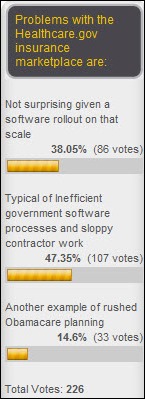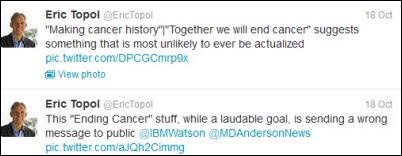Merry Christmas and a Happy New Year to the HIStalk crowd. I wish you the joys of the season!
Monday Morning Update 10/21/13
From Across the Pond: “Re: Epic. Two large academic hospitals in Amsterdam, AMC and VUmc in The Netherlands, signed a contract with Epic last week.” Academic Medical Center has 7,000 employees, 2,300 medical students, 120 medical informatics students, and an annual volume of 26,000 admissions and 350,000 outpatient visits . VUmc, which cooperates closely with AMC, is affiliated with the other big university in Amsterdam. Wikipedia says The Netherlands has eight university medical centers and 10 large non-university hospitals.
From Jane Jetson: “Re: Weight Watchers. I received an email this morning owning to the fact that they had technical problems. Perhaps I should forward to Kathleen Sebelius so that Healthcare.gov could borrow the wording.” The problem with the government is that nobody is ever individually responsible for anything; the incompetence is collective. It would be unheard of to acknowledge that something isn’t working except for political gain, or to accept responsibility for anything but success. All of the professional bureaucrats are busy trying to hang onto jobs that must be pretty sweet given their ducking and covering to keep them.
From Kittanning: “Re: startups. Why don’t you cover more startups? That’s where the innovation will come from.” I cover startups that have interesting consumer-facing technology, but rarely those who are targeting hospitals. Reason: most of them think their great technology idea will offset the founders’ lack of knowledge (and lack of interest) about how hospitals and doctors work and who just want to cash in quickly rather than helping patients or providers. Newbies can’t come in guns blazing telling everyone in healthcare that they’ve figured it all out as a 30-year-old programmer turned self-proclaimed CEO, insulting those who have more years in healthcare than they’ve had breathing, and nobody in a position of enterprise IT responsibility is going to be impressed by swaggering overconfidence from unpolished newcomers who think they’re the next Steve Jobs just because they are as abrasive as he was. I’ve seen very few great startup ideas that have the potential to turn into anything more than a spare bedroom business, and of those, only a tiny percentage are being run by people on whom you’d make even a small bet as a customer or investor. Creating enterprise technology innovation, unlike writing cute iPhone apps, requires a lot more than a Foosball table and cases of Red Bull. I’ve seen company pitches, most of them naive and unskillfully prepared, and the commonalities are: (a) lack of money and of a realistic plan for profitability that will allow ever bringing their product to scale; (b) a low barrier to entry that virtually guarantees that any degree of success can quickly be replicated by competitors; (c) lack of realization that it takes a lot of skill, money, and time to connect your great idea to hospitals even willing to undertake a pilot, much less buy the product, and the lack of appreciation of just how long the hospital sales cycle is and how imitative their purchases are; (d) having no one on the team who has ever sold technology to hospitals or partnered with similar firms; and (e) lack of understanding that people bet on the jockey, not on the horse, and impressive developers usually don’t make impressive CEOs regardless of their level of hubris. Great ideas are a dime a dozen; the hard work is the long, expensive slog trying to get traction with them, and if you are new to healthcare selling a product whose target customer is hospitals, it’s a near-certainty that you’re going to justifiably fail, with your only hope that a better company will buy yours before it splats to the ground. That’s not anti-innovation at work – it’s the reality that healthcare attracts a lot of flaky, poorly thought out startups that don’t deserve to succeed. Come back when you hit $1 million in annual revenue.
From The PACS Designer: “Re: Omate watch. Another watch, funded through Kickstarter, is now available for purchase starting at $249. The Omate TrueSmart Watch can be used as a phone with its Bluetooth capability while still being fully functional without the phone. This no-hands phone style of watch will surely be used in healthcare settings.”
From Expense Reports Gone Wild: “Re: consultants. I continue to get bothered by the number of submissions on the bills of consultants for coffee, snacks, lunch, dinner, beverages, protein bars, etc. Why is it that we as a customer are expected pay for all this sustenance? Is the $200+ hour not enough? I am fine with paying for folks to get from home to the location, but why has there been this tradition of paying for other than travel? I think it is time to begin to object to these costs. If we are going to be part of saving health care we can’t continue to exacerbate the issue with rampant unnecessary spending. I have heard all the arguments around inconvenience of travel and this to make up for that but then let the employer of that person eat the cost. The per diem fee doesn’t fly either — when I go to work, I have to pay for my food, just because work means getting on a plane doesn’t excuse one from that obligation. Convince me I am misguided.” I agree, but taking the counterpoint as a consultant might, I could make the same argument for buying $500K hospital CIOs cars, club memberships, travel of a questionably patient-valuable nature, and bonuses for doing the job they were already paid to do. I think the conclusion is that everybody gets to pass the literal buck down to the patient bill, and only recently did big hospitals worry about their inability to create enough charges to pass through the excessive costs.
The problems with Healthcare.gov are either due to (a) screwed-up government software bidding and contractor oversight , or (b) not unexpected for a rollout of that scope, say most poll respondents. New poll to your right: is the influence of private equity firms on healthcare IT positive or negative? Your answer doesn’t provide any context, so after you’ve voted, click the Comments link to explain.
Welcome to new HIStalk Platinum Sponsor Sentry Data Systems, which offers hospital pharmacy procurement, revenue cycle, and compliance solutions. Sentinel RCM manages financials, inventory, charge master, auditing, and order flow, allowing them to track drugs from the point of purchase all the way to billing. Sentrex helps hospitals manage their 340B contract pharmacy relationships to maintain compliance by using a proprietary rules-based engine to apply hospital policies and procedures, supporting both 340B and Own Use programs. These products run on the Datanex infrastructure platform that processes millions of transactions each day. Hospitals running a 340B drug program need specialized technology to avoid running afoul of a maze of regulatory and auditing challenges and Sentry is the company to call. Thanks to Sentry Data Systems for supporting HIStalk.
I cruised YouTube for more on Sentry Data Systems and found this pharmacy director testimonial.
AtHoc is a brand new HIStalk Gold Sponsor. Over 200 hospitals rely on AtHoc for critical communication and personnel safety, turning their IP network into a closed-loop, multi-modal notification and communication system. Examples: protecting home health nurses with a smartphone duress/panic button, communicating with clinicians during IT downtime, and automating shift availability and filling processes. Above is a video on Kaiser Permanente’s use of AtHoc for staffing. Thanks to AtHoc for supporting HIStalk.
Athenahealth turned in unimpressive numbers that fell short of expectations Thursday, some but not all of them related to its Epocrates acquisition, but that didn’t stop shares from going on a tear after the announcement. ATHN hit an all-time high Friday and closed up 24 percent on the day at $130.83, valuing the company at almost $5 billion. Investors apparently ignored the financial results and instead were encouraged by a growing client base and an extended contract with PSS World that will put more salespeople on the ground pushing athenahealth offerings. Above is the one-year chart of ATHN (blue) vs. the Nasdaq (red). Jonathan Bush holds $40 million worth. From the earnings call, which is always informative whether you care about ATHN or not because Bush is willing to say what others won’t:
- One large client, an ambulance company that was never named at that company’s request (but had to be Rural/Metro), went bankrupt even before going to pilot with athenahealth and “new leadership fired us.”
- Like everybody else, athenahealth talks about population health a lot.
- The company will roll out athenaKnowledge in 2014, which will provide financial and clinical decision support to physicians.
- AthenaClinicals can automatically make a note in the chart when patient prescriptions are filled, although so far that works in only about 23 percent of orders.
- AthenaClinicals users who also use athenaCoordinator can exchange patient information via athenaNet with no additional interfaces or exchanges.
- When asked whether athenahealth would gain or lose hospital business through consolidation, Bush replied, “I don’t know, dude. I assume we’ll win. I mean — the for-profit sector is where most of these mergers are going on that you’re talking about, and it’s a very rational sector. Most of the headwind we face in the enterprise world is with institutions who don’t view their bottom line as all that important. And their reputation as the bringer of great new physicians into the world and their reputation as the provider of procedures that no one else can provide, trump their abilities, their interest in asset efficiency. Now as we’ve said in past calls, we believe that asset efficiency is going to rise in appeal to even the most theoretical of academic medical centers as the pressure builds.”
- According to Bush, “At some point, the idea of information being liquid across people who don’t own each other is a major trump card when you think of this tragic lemming march of acquisitions, doctors and hospitals marrying up in marriages of convenience, nothing wrong with doctors and hospitals marrying up in marriages of love, but this wave of kind of moony, large-scale marriages of convenience just to get information integrated when there is another way, to me, it’s sort of a profound megatrend to watch.”
- When asked about hospitals using athenahealth products to control physician behavior, Bush said, “Well, I’ll tell you every proposal to a new enterprise today include a Google Map of all of the doctors that have admitting privileges at their institutions that are already on athenaNet. And those Google Maps are getting more and more dotty, lots and lots of little dots around their blue H. And the fact that now we don’t say we can direct, but we say, ‘Listen, hospital, do you want to — speaking of manifestos, do you want to get compliance via force or do you want to get compliance via love?’ … be the most high-quality, easy-to-do business with receiver of patient referrals. Be big and successful and survive this drought that’s coming by being the best, and that means being the most integrated, the most available … we don’t even need the tipping point for that, right? We could just show up and say, hey, you’re going to do a go-to-market strategy with your subsidized EMR the way poor Long Island Jewish did with Allscripts banging away, giving it away at red lights, trying to get the windshield wiper guys to give it away. Here, you got thousands of doctors paying for it, wanting it, and all you’ve got to do is light up your logo inside of the order screen.
- On selling athenaClinicals to customers who already have an EMR, “I know the last time I looked, it was 40 percent of our clinical sales today were people throwing one out … you have a huge wave of folks who looked, went out and jammed the EMR thing because Obama told them to, and then they got to Meaningful Use day and they got nothing … Used properly, they’ll get you Meaningful Use. But doctors are not supposed to be using them properly. All they’re supposed to be doing is seeing patients … Nobody wants to go back to their Board of Directors or their Board of Doctor Owners and say, ‘Yes, so sorry but I convinced you spend thousands and at times, millions of dollars on something that I really want to throw out now.’ But it is what it is. It’s a cash-on-cash no brainer. You just have to go through the embarrassment.”
John Lynn did an ICD-10 Hangout on EMR & EHR Videos.
GE reports Q3 numbers: revenue down 1.5 percent, adjusted EPS $0.31 vs. $0.33, but train and plane sales along with aggressive cost-cutting helped the company exceed Wall Street’s expectations, sending shares to a five-year high. GE Healthcare’s sales were flat, but earnings rose 7 percent.
A series of Wisconsin Democratic Party focus group meetings identifies the two favored candidates for governor, one of whom is Judy Faulkner of Epic. The strengths the groups favored were a wealthy, politically outsider woman not from Dane or Milwaukee Counties with name recognition who hates everything about Republican Governor Scott Walker. I don’t think I’d take the results too seriously since they seemed to favor celebrity status over political qualifications – the group’s other choice was just-retired Green Bay Packer and “Dancing with the Stars” winner Donald Driver.
Eric Topol, MD isn’t impressed with MD Anderson’s use if IBM’s Watson to undertake a “moon shot” aimed at eliminating cancer. He tweeted, “This ‘Ending Cancer stuff, while a laudable goal, is sending a wrong message to public.” He didn’t explain, but I assume he meant that cancer isn’t one disease and the likelihood of eliminating it, with or without Watson, is nearly nil. Prevention is more important than treatment, I conclude, but if MD Anderson thinks Watson can help eliminate cancer (or help it market itself to cancer patients, which bring it nearly $4 billion per year in revenue for treating cancer rather than preventing it), then it’s worth a shot, moon-worthy or otherwise, even if it does encourage minimally intellectual Americans to think that anything less than a cure is a failure.
Val Jones, MD (aka blogger Dr. Val) says that despite her previous support of digital data in medicine, EMRs are doing more harm than good. Her reason: data entry is “an enormous time-suck for physicians” that harms thoughtful interaction with patients that would allow a correct diagnosis and sensible treatment plan. She doesn’t like correcting offshore transcription, hospitals with large IT departments (“40 young tech support engineers were furiously working to keep the EMR from crashing on a daily basis”), and EMR-required data fields (she called out Allscripts, whose system requires the doctor to indicate for every discharge prescription whether the medication comes in a tablet or capsule, which the system knows full well but which has to be entered again to allow the inpatient EMR to accept the information). I think she might have aimed her wrath more precisely at the one hospital at which she apparently had a bad experience since what she describes is certainly not universal, but certainly some hospitals are exactly as she describes.
Peace River Center, a Florida non-profit psychiatric agency, is awarded a $30,000 United Way of Central Florida grant to implement technology that will allow its home case workers and clinicians to remotely connect to its EMR.
In Canada, Victoria County Memorial Hospital loses its telephone service and Internet connectivity when a construction vehicle severs cables, causing the hospital to cancel walk-in diagnostic and lab services.
Twitter’s just-announced November IPO may be tarnished by “Twitter quitters,” those who try the service but abandon it because they can’t figure it out or don’t find value in it. A new poll shows that 36 percent of those who sign up for Twitter don’t use it and 7 percent close their accounts, much worse numbers than for Facebook. According to an active Facebook user who stopped using Twitter, "I didn’t really get the point of it at all. Most of them were people I wasn’t interested in hearing what they had to say anyway.” Twitter is big, but then again so were Second Life and Myspace.
Madison, WI-based 11-employee Wellbe raises $1.4 million in funding. The company’s Patient Guidance System, which it describes as a GPS for health, sends patients emails and information before and after their surgeries.
HHS gave UK-based government contractor Serco, under investigation there for contract fraud, an $87 million contract extension to its existing $114 million CMS contract to handle paper insurance applications just five days before the launch of Healthcare.gov, leading to speculation that the government knew Healthcare.gov was going to fail and paid Serco to handle the inevitable flood of paper-based insurance applications. However, CMS suggests that the Congressional Budget Office had estimated that 20 million people would apply, with 6 million of those doing so on paper, and the 2,000 people Serco hired were necessary to process the paper applications. HHS gave Serco a $1.2 billion contract in July to manage paper insurance applications for 34 state insurance exchanges in its first-ever US healthcare project. The parent company has annual revenue of around $8 billion. Serco took over NHS’s largest hospital pathology laboratories in 2009 in a privatization joint venture worth $1.3 billion over 10 years and was involved in a series of admitted serious patient errors, including losing samples, incorrect computer flagging resulting in administration of inappropriate blood, a software problem that calculated kidney function incorrectly, and a section of blood chemistry equipment that had to be shut down for four days after a computer virus infection. The 1,000-employee JV, called GSTS Pathology, couldn’t control its costs, had to borrow money from the hospitals to continue its operations, and announced that it would need to pull out of certain markets. GSTS Pathology continues to bid on new UK business, hoping to capture 30 percent of the pathology market.
California Attorney General Kamala D. Harris issues “Medical Identity Theft – Recommendations for the Age of Electronic Medical Records.” It cites a recent report stating that nearly half of medical identify theft isn’t really that at all – it occurs when someone with insurance loans their card to someone who doesn’t have insurance. EHR-specific recommendations include:
- Implement role-based access controls.
- Embed a copy of a patient’s photo (but not a government-issued ID) into the EMR.
- Give patients clear instructions on how to get a copy of their information.
- Give patients a copy of Clinical Care Summary documents asking them to verify the information but warning them keep it confidential.
- Set up the EMR to flag suspicious issues (known a “red flags”), such as a patient refusing to show an ID (other than in the ED); presenting an ID whose photo doesn’t match their appearance; presenting an ID with a name or address that doesn’t match the EMR information; giving a Social Security number, address, or telephone number that is already assigned to another patient; receiving returned, undeliverable mail from the patient’s address; receiving previous denial of payment for situations such as a second appendix removal; bills returned as undeliverable while new charges continue under that same address; patient interview information is inconsistent with the EMR information; observing that a patient is not aware of the information in their record; and finding information in the EMR that conflicts with other information or with the patient’s presentation.
- Develop a process for instantly reporting any of the red flags above to a team that will review all available records and place affected accounts on hold, looking for problems such as erroneous data entry or inappropriate medical records merge.
- Document findings and policies in the EHR where it can be seen.
- Create a database of identities that have been used fraudulently.
- Add a message to the patient portal encouraging patients to review their records regularly, also giving them instructions on how to report discrepancies.
- Audit EHRs for unauthorized access.
- Build demand for provider detection software, which the report says is offered by only a handful of unnamed vendors whose applications are too expensive for all but the largest health systems.
- Correct records as needed, either annotating them or moving them to a specific “medical identify theft” location and then starting a new record.
- Use the Continuity of Care Document to electronically notify business associates and other providers that the record has been corrected.
- Follow HIE rules for correcting information.
- Encourage development of technical standards that would allow Health Information Organizations to exchange red flag information, such as modifying the MPI to indicate the addition of a red flag by a member.
- ONC should include red flag recommendations in Meaningful Use Stage 3.
Weird News Andy titles this story GIGO, wondering, “Who, if anybody, tested this thing?” (answer: government contractors). Not only is Healthcare.gov failing to allow most would-be users to get into the system, it’s also sending erroneous data to insurance companies from those who do. Duplicate enrollments, spouses listed as children, and missing data have been reported.
WNA also files these reports from his Weird Newsroom. Doctors are unable to determine why a Tennessee man has been crying blood for seven years, an unnerving trait that has cost him every job he has held. A Denver woman whose arm was unnecessarily removed after an incorrect cancer diagnosis tries out a robotic arm, but her rare underlying condition remains – any bruise she gets turns to bone, which is gradually transforming her into a human statue who knows she will be fully immobile soon.
A hospital sues one of its patients who refuses to leave because she likes her bed there. The patient was discharged after a four-day stay for pneumonia, but intentionally had her state-provided hospital bed removed from her home so that she could argue that her discharge was unsafe. The hospital says the patient is abusive to staff and fellow patients, complains if her room is at any temperature other than 83 degrees, and repeatedly calls the police department, public health department, and the attorney general to complain about her stay. The hospital wants a temporary injunction to send her packing.
Vince continues his fascinating HIS-tory of McKesson, specifically HBO, with information he received directly from Walter Huff himself. It’s fascinating to read how many early HIT pioneers were hospital CFOs who did programming or other computer work for their hospitals, and how many vendor systems came out of those hospitals.
Contacts
Mr. H, Inga, Dr. Jayne, Dr. Gregg, Lt. Dan, Dr. Travis.
More news: HIStalk Practice, HIStalk Connect.














I agree with Val. Thanks for reporting on her conversion to reality. You seem to be depreciating her message. The usability of each and every EHR system is suspect, but no one wants to admit it and require remediation expeditiously.
Well back in 2009 I made a very unpopular post on my blog, that please don’t put nominate Sebelius for HHS and it was not personal at all. I said put the “smart” folks in office and that give it a few years Health IT would eat her up. I’m not the only around with that idea but maybe the only one that decided to write it up. SEC, DOJ have same problems and we are getting to the point to where figureheads can’t realistically run IT Intense federal agencies. You have seen the same stuff I have seen out there and when the “Hurry up Health IT articles” came out, well that told me that exchanges were having issues in February. We can’t hurry things up and talk about water boarding developers now can we:) Allscripts a couple of years ago would have liked to hurry their integration too and it cost a CEO his job with not being honest too:) I wrote another one too bringing in DeParle, same tone about having the background of handling the extreme business intelligence used by payers today and understanding what the other side has going on:)
http://ducknetweb.blogspot.com/2009/02/kathleen-sebelius-kansas-governor-for.html
It is sad indeed as HHS I think has found themselves boxed into a corner and not saying they are bad folks at all and they work their buns off but leadership with having a “hybrid” at the top is really needed. Heck if he would consider it, I wouldn’t mind seeing Dr. Halamka running it as he’s about one of the smartest and most logical individuals out there, but the man need to have a life too so whether or not he would consider it is yet another question.
I also posted about both Oracle and Microsoft both having a “state” turnkey insurance exchange solution platform, don’t know if either was used or not but being Oracle technologies are being used I would think there would be some good interoperable code to be had and at least look at it rather than a build of one as I understand CGI did. The hearings this week, well the other side out there is not too smart out there either and I suggested we get one of those wellness portals in place for all of Congress (a bit of satire here) but hey let’s get some “risk metrics” going on these folks and some pay for performance for these folks and get some behavior algorithms and place and see if they can crack some of the most hard core folks out there needing behavior modifications:) Why not! Hopefully it might a chuckle or two just to think about this prospect:)
http://ducknetweb.blogspot.com/2013/10/congress-needs-wellness-portal-as.html
The long and short of all of this is that both government and consumers are learning a real hard cold less about IT infrastructures as they exist today and Included a tiny bit of what happened to me in the early days while developing…and what MDs would say when I showed up with the next software upgrade and we have all been there:) I think the expectations of what an be accomplished with time frames and money are not synched very well out there and we can’t do it like we did in the old days before platforms as reliance and not only in healthcare but in general relies on code somebody else wrote and if you have big pyramid of platforms stacked up, well anything can and does happen even though it’s tested by the best. So whether it’s a stock exchange or health insurance exchange I think it’s time to start educating the public and government on the real complexities, otherwise you have developers and engineers held to a status of being magician in places where it’s not going to happen like it used to.
http://ducknetweb.blogspot.com/2013/10/us-consumers-and-government-are.html
@ Medical Quack…..I appreciate your passion, but you really need to pay closer attention to your grammar/syntax/spelling. If you’re going to post long diatribes you owe this, at the very least, to the readers. Otherwise you really shouldn’t post.
Present generation of EMRs may have their problems especially regarding productivity but personal anecdotes and one-off examples provide little insight into the benefits or problems with EMRs today. It always frustrates me to see when local TV news or print media gets one or two quotes and somehow tries to apply this as being in any way representative of some kind of larger issue. It isn’t.
Whew, Mr. H, how do you really feel about startups? I don’t disagree with the sentiment that there are a ton of hopeful ideas that are under capitalized and inexperienced. We are perhaps seeing more of that now than ever.
But…. There are some that have been started by insiders and attract serious folks to make it go. Let’s not be too distracted by the noise.
Mr. H – Brilliant response to Kittanning’s question about start ups. Seems he touched your last good nerve today, as I’ve never seen such a stream of consciousness from you – at least one that long. I fully agree with what you’ve said here and I’m one of the people who’ve had “good ideas” for years that always crash and burn on the very rocks you outline.
Which is why you are where you are.
@Medical Quack. I wholeheartedly agree with football. I’m assuming the passion you have but find it really difficult to get through your post. Honestly, I couldn’t finish reading it…and have trouble giving any of the parts I did read any credibility.
To Frugal: Sorry to hear that you’ve had issues with consultants padding their expenses. I’ve seen lots of abuses, so I sympathize, but the idea that you shouldn’t pay for food and legit expenses onsite is selfish and skin-flint. When I’m at home, I eat out maybe once a week and pack my lunch. When I’m onsite, I can’t do that because almost no clients will pay for me to stay at a place that has a kitchen and let me stay there long enough to make grocery shopping make sense. So, it’s eat out three times a day. And that is VERY expensive. Certainly far more than the per diems I’ve ever seen! So understand the truth: you’re subsidizing my expenses, not paying them (and if you really are throwing more money at consultant than they spend, then we need to talk!).
But let’s address the bigger issue: you have no problem overpaying consultants on their hourly rates (who on earth are you paying $200+/hr and are they really worth it? I have NEVER met a consultant who was worth that much and I am a consultant!), yet you want to nickel and dime these people over a coffee? Seems like you are focusing on the wrong thing. And if you don’t like consultants, start hiring decent FTEs, pay them appropriately, and you’ll find that you can dispense with the consultants.
Mr H – interesting response about consultant expenses. Do you really think that the very, very rare $500K CIOS and their perks (if you hear about an opening let me know) is a valid comparison to the armies of consultants (and I am a former one as well) and their exorbitant rates and nickle-and-dime expenses?
Holy Moly Batman — You hit the nail on the head! As someone who has worked in healthcare IT since 1976, I have seen many great ideas come and go and die because the person with the idea suffered from all the maladies outlined in your brief piece on start-ups. Most of them did not even know enough to realize they were the cause of their own demise. Humility and perseverance foster eventual success.
Old timer
I agree with Lazlo Hollyfeld. If EMRs are so bad, give us some cold, hard facts with case studies. I understand that change is difficult, but change is also inevitable. There’s no going back to paper unless you want to practice in some remote little town somewhere. Instead of grousing about the problem, participate when asked and become part of the solution.
From Kittanning: “Re: startups. Bravo, Mr. H! I could easily repurpose your response to address the reasons why healthcare companies need to stop hiring sales/product/marketing employees who do not have healthcare experience. It’s the same mindset. Seems it is not only the 30-year-old programmer i.e. self-proclaimed CEO but also the average 22 -30-year olds who “know” they can revolutionize this business and are God’s gift to the end-state solution. Eventually, the experienced few are forced to clean up their messes after they are terminated or worse…promoted.
Also $200/hr is rarely the actual take home for consultants- I’ve never met anyone pulling in this much. Don’t forget that staffing firms which barely do as much as pick up a phone and process expense reports cut off a third or more of this rate for themselves. If hospitals would hire staff aug consultants directly, the rates would definitely go down and maybe even expense budgets could be negotiated more logically.
I loved your comment regarding start-ups and innovation ” the hard work is the long, expensive slog trying to get traction …. Come back when you hit $1 million in annual revenue. ” The genius is in the commitment. com·mit·ment.
I think we are still living in the “consultant must be on site” mentality as well. I see a lot of the travel we are required to do only serves to be sure the client sees us and sometimes hold their hands.,.,.,,there is so much more that can be done remotely, and make much better use of time…